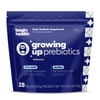Your Cart is Empty
Continue shopping3 Foods that Help Magnesium Absorption in Kids
Medically Reviewed by May Zhu, RDN | Published May 24, 2024
share this article

Magnesium is a crucial mineral that supports your kiddo’s growing body from building strong bones and supporting healthy muscles to powering the nervous system and even helping digestion. But here’s the challenge: getting enough magnesium from diet alone can be tricky, and many kids fall short.
Thankfully, certain everyday foods don’t just contain magnesium. They can actually help the body absorb more of it. Here’s a closer look at 3 magnesium-rich foods that can help support absorption and boost your kid’s overall health.
Why Magnesium Matters for Kids
Magnesium plays a role in over 300 enzymatic reactions in the body. It helps regulate muscle and nerve function, supports steady blood sugar levels, and contributes to healthy blood pressure. It’s also essential for forming protein, building strong bones, and creating DNA, all big jobs for growing kids.
Low magnesium levels in kids may lead to symptoms like fatigue, muscle cramps, or poor sleep. Over time, a deficiency could even contribute to more serious health issues.
Begin Health Expert Tip
Did you know that there are several different types of magnesium?Check out the magnesium that best helps your kids with a healthy digestion here.
1. Leafy Green Vegetables
Leafy greens like spinach, kale, and Swiss chard are packed with magnesium and they also contain compounds that help the body absorb it better.
-
Magnesium content: One cup of cooked spinach has around 157 mg of magnesium, nearly 40% of a kid's daily needs.
-
Bonus benefits: Leafy greens are rich in vitamins like B6, which can help enhance magnesium absorption (1).
They’re also high in chlorophyll, the green pigment in plants that naturally contains magnesium, making these greens a double win for your kid’s plate.
Daily reads to help your little ones lead happier and healthier lives.
Buy Now
Join the
Happy Gut Club
2. Nuts and Seeds
Almonds, pumpkin seeds, cashews, and sunflower seeds are all fantastic sources of magnesium and they’re easy to snack on or toss into smoothies or yogurt.
-
Magnesium content: One ounce of almonds contains about 77–80 mg of magnesium.
-
Why they help: The healthy fats in nuts and seeds help your body better absorb fat-soluble vitamins and minerals like magnesium (2).
But here’s the catch: raw nuts also contain phytates, natural compounds that can block mineral absorption. The good news? Soaking or lightly roasting nuts can reduce phytate content, making magnesium more available (3).
3. Legumes
Black beans, lentils, chickpeas are all plant-based powerhouses are rich in magnesium and help set up a healthy gut environment for better absorption.
-
Magnesium content: One cup of cooked black beans contains around 120 mg of magnesium.
-
Gut support: Legumes are high in fiber and prebiotics, which feed good gut bacteria. A healthy gut microbiome has been shown to improve mineral absorption, including magnesium (4).
-
Protein power: Some amino acids in legumes may also help transport magnesium into the body (5).
They’re an all-around digestive and mineral absorption win, especially for picky eaters who may not be fans of green veggies.
Summary
Magnesium is essential for kids’ health but getting enough, and absorbing enough, is key.
By adding leafy greens, nuts and seeds, and legumes into your family’s meals, you’re not just adding magnesium to their diet, you’re making it easier for their bodies to use it.











